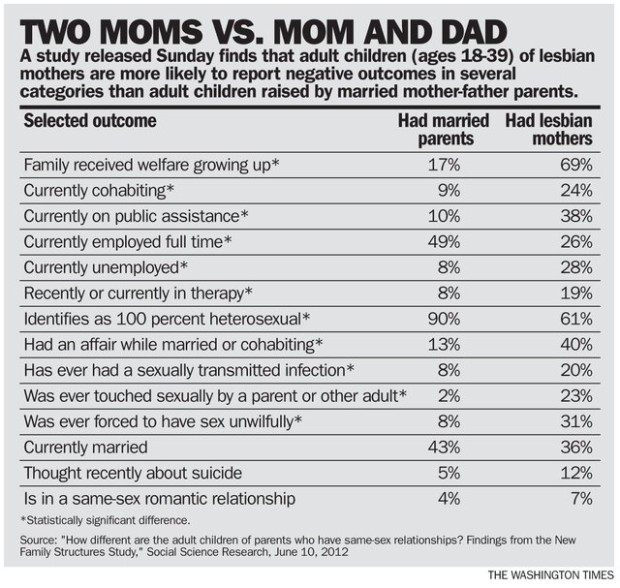The Fallout of Lesbian Motherhood
The following article was originally published by Illinois Review.
One children’s book proclaims, “Heather Has Two Mommies,” but an updated edition could read, “Heather Has Two Mommies, an Increased Chance of Depending on Welfare, Being Forced to Have Sex, and Being Less than 100% Heterosexual.”
This is the legacy of lesbian motherhood as shown in the recent study “How Different are the Adult Children of Parents Who Have Same-Sex Relationships?” written by Dr. Mark Regnerus and published in the journal of Social Science Research on June 10.
Dr. Regnerus compiled data from over 3000 American adult children aged 18 to 39 from a variety of households and analyzed 40 major questions. While other studies on heterosexual and homosexual parents have focused on data from children, with parents answering questions, he decided to interview adults because they could speak for themselves.
The summary generated by the Washington Times is shown below:
There are distinct differences in children raised by heterosexual parents and those raised by lesbian mothers. Not only are children of lesbians more likely to grow up dependent on public assistance, they are also more likely to continue this dependence into adulthood and be under- or unemployed. Even more seriously, such children are more likely to be abused sexually and commit adultery as adults.
Not every child raised by lesbians follows the overall pattern, but when it comes to probabilities, the study concludes that “children appear most apt to succeed well as adults—on multiple counts and across a variety of domains—when they spend their entire childhood with their married mother and father, and especially when the parents remain married to the present day.”
Previous studies have showed either no difference between children raised in homosexual or heterosexual families, or even a benefit to children raised in homosexual families. Dr. Regnerus points out that many earlier studies suffered from small sample sizes and “convenience bias,” with respondents recruited from privileged venues such as lesbian events and women’s bookstores. Dr. Regnerus, by contrast, sampled more people from a wider swathe of the population using a method similar to that of the U.S. Census Bureau.
Organizations such as the Gay and Lesbian Alliance Against Defamation (GLAAD) have been quick to take issue with Dr. Regnerus’s study, claiming that his methods were flawed because he did not account for family transitions and that his conclusions disagree with common knowledge.
The common knowledge truly challenged, however, is the carefully crafted image of a committed pair of homosexuals deciding to bring children into their home. Not every homosexual who decides to adopt is in a committed, long-term relationship. Also, there are variations in how a child comes to a homosexual family. Every monogamous homosexual couple is infertile, but can participate in artificial insemination, surrogacy, or adoption if they decide to add children to their home. These methods are becoming more common in younger homosexual families, but many of today’s adult children of homosexual parents were the products of dissolved heterosexual unions.
In a recent Daily Texan article, a lesbian mother criticizing Dr. Regnerus mentions in passing that her children were the product of a heterosexual marriage, that she had multiple lesbian relationships, and has only been in her current lesbian relationship for three years. For her children and others like them, a family transition was how they joined the family and is thus impossible to exclude from the results.
This study’s findings about children raised by lesbian parents is challenging many established notions and demonstrating the importance of moving beyond the results of a few select families to the broad-based results from average families. In the end, the fundamental question is not over Dr. Regnerus’s methodology, but over the rapidity in which lesbian adoption is being accepted. Homosexual parenting is a new social experiment with broad implications ethically, politically, and economically.
Going forward, parents and policy makers should heed Dr. Regnerus’ concluding words of caution: “Insofar as the share of intact, biological mother/father families continues to shrink in the United States, as it has, this portends growing challenges within families, but also heightened dependence on public health organizations, federal and state public assistance, psychotherapeutic resources, substance use programs, and the criminal justice system.”

